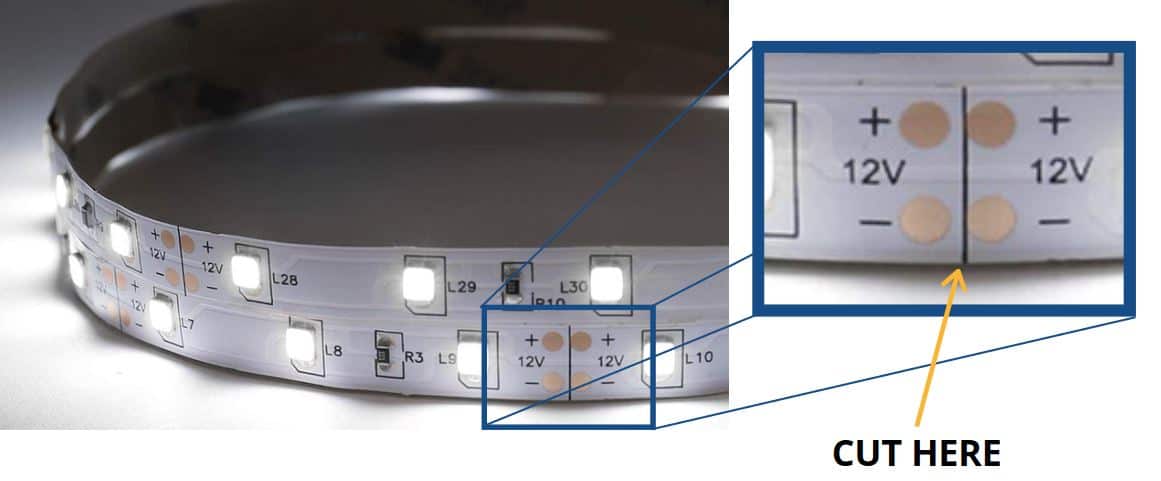LED strip lighting is perhaps the most fan-favorite application of LED light. It has many uses and can instantly take the mood of the room to new places.
But there are many variations of LED strip light to choose from. One of the key decisions is which voltage of LED strip is right for your home.
So, 12v vs. 24v LED strip lights – what’s the difference?
12-volt LED strip lights have more frequent cutting points, making them easier to customize for your home. 24-volt strip lights can be installed over longer distances, that makes them more efficient and better suited to commercial installations or serious LED strip projects.
In this guide, I’m going to explain to you:
- The main differences between 12v and 24v LED strip lights
- Whether strip voltage impacts brightness
- If 24-volt LED strip lights work on 12-volt power
4 Main Differences Between 24V and 12V Strip Lights
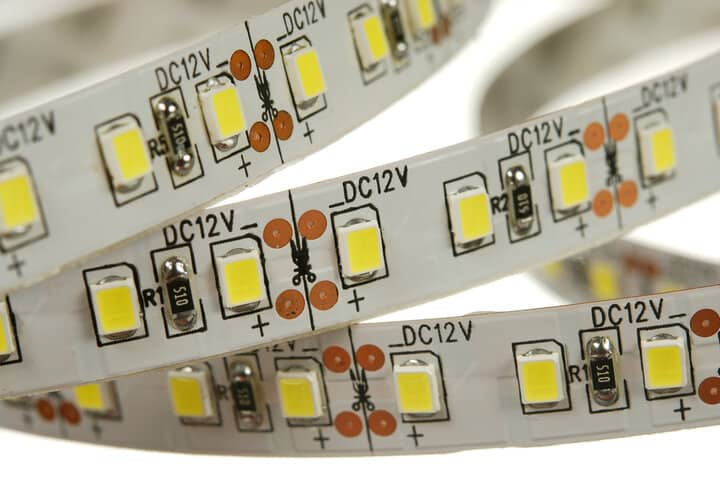
The main differences when comparing 12-volt vs. 24-volt LED strips are:
- The distance between cutting points is greater on 24-volt strips
- You can connect more 24-volt strips together before voltage drop occurs for 24-volt options
- 24-volt strips waste less energy and won’t overheat as easily
- 24-volt strips can use a smaller power supply
Most LED strips sold for the home are the 12-volt variety, with the higher voltage of a 24v LED strip being considered a premium option. 12v LED lighting is sufficient for the home, but you may have certain requirements that necessitate the 24-volt strip lights.
Let’s take a look at the differences in more detail.
Cut Points Are Longer In 24V Strips
12v LED strip lights have more cut points along the strip, compared to the 24V strip. This means you can cut 12v LED light strips to the desired length much easier.
As a general rule, there are usually two cut points on a 12V strip for every one cutpoint on a 24V strip.
This is an important feature to consider if the project you have planned involves a significant number of corners and perpendicular lines. You would need to keep cutting the strip to follow the edges; the 12V would be better suited.
If that is not particularly the case and your led strip lights are going to be more or less running in a straight line, you can choose either the 12V or 24V without any issues.
Number of Connected Strip Lights In Series
Provided everything else is the same, a 24-volt strip can carry the current to longer distances through the strip wires before the strip starts to experience voltage drop. So the higher voltage strip has a longer maximum continuous length without losing brightness.
Voltage drop is when the brightness reduces down the line, as the number of LEDs that need to be powered and their total resistance increases.
A high-quality LED light strip supplied with 24 volts and run for 20 meters would show a drop of around 12% from the start to the end.
With a 12-volt strip, a drop of more than 25% would be recorded, and that is a visible difference that can be seen by the eyes. The LED chips at the far end of the strip light would be noticeably less bright.
For installations of less than 10 meters, 12V strips should serve you fine. Longer than 10m, and the better quality result would be from a 24V strip.
However, if you have multiple power supplies, you can opt for 12V strip lights powered from the two ends of the strip light to sustain consistent voltage across the LEDs.
In any case, it is not the most energy-effective technique to connect all your strips into one single line and loop it back to the starting point to cover a rectangular ceiling, for example.
A smart approach would be to place a PSU on one corner of the rectangular ceiling. Then, connect two LED strips in parallel to the power supply.
Lower Electrical Conductor Requirements
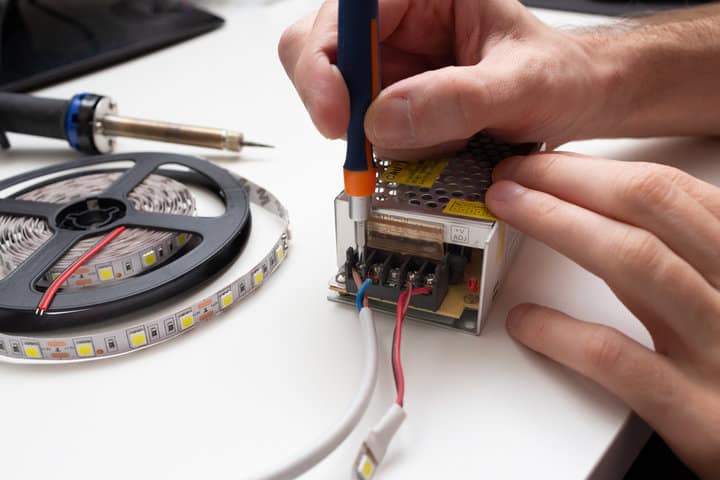
24v LED strip lights draw less current than those with a lower voltage, which means they don’t need copper conductors as thick as a 12-volt strip. It also means they are less at risk of voltage drop and overheating.
This point isn’t a major benefit because it depends on the manufacturing quality of your LED light strips and the wattage of your chosen strips. But it’s useful information to know.
Remember that, in any electrical system, the equation for electrical power is always the same. P = V x I, where P = electrical power (wattage), V = voltage, and I = current (measured in amps).
If you have strip lights with the same power level of, say, 48 watts, then a 12-volt light strip needs four amps to power it. Whereas higher voltage strips that run on 24 volts only need two amps.
This means that you’re getting the same target output while you only draw half the current.
If the copper wiring used in both light strips is the same, it means you’re not pulling as much current through the conductors. This means less risk of overwhelming them, which can cause voltage drop and also lead to electrical fires, if they overheat too much.
Alternatively, it means that 24-volt light strips can be safely manufactured with a more narrow copper conductor, since it doesn’t need the same amount of amps to create the same light output.
This also impacts the next section…
Power Supply Size
24-volt LED strips can use smaller power supplies, because the internal copper wire can be thinner due to the lower amperage. This makes for a more convenient installation solution for under-cabinet lighting.
You can find power supply options with a lower profile that are easier to plug into smaller spaces, so you don’t have to have a bulky unit that spoils the look of your installation.
As mentioned earlier, the 24V supply would allow for more strips in series before the brightness starts reducing.
Are 24V LED Strips Brighter Than 12V?
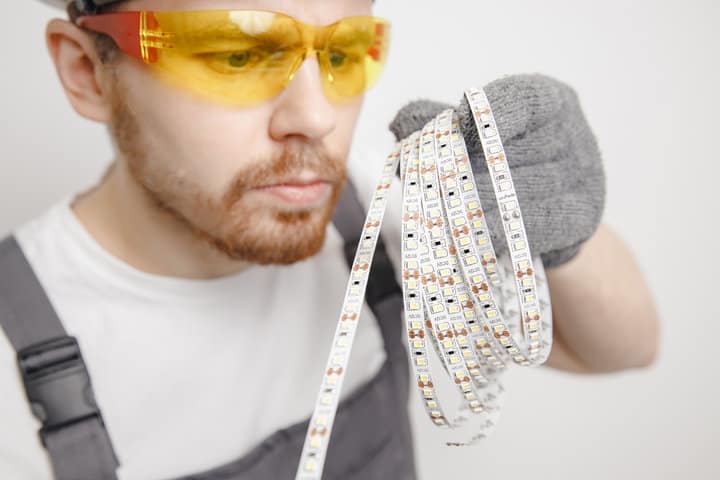
Voltage doesn’t impact the brightness of your LED lights. When using a 12-volt or 24-volt LED strip correctly, within the maximum run limit, there should be no difference in the brightness in the two voltage strips.
The brightness in strip lighting is described in lumens per meter (or foot). A high-quality LED strip will usually provide around 1500 lumens per meter (or 450 lumens per foot).
The number of LEDs per length unit will determine the brightness and how much power the strip will draw per unit length. The higher the wattage per length, the brighter the strip will be.
Will 24V LED Strip Lights Work on 12V?
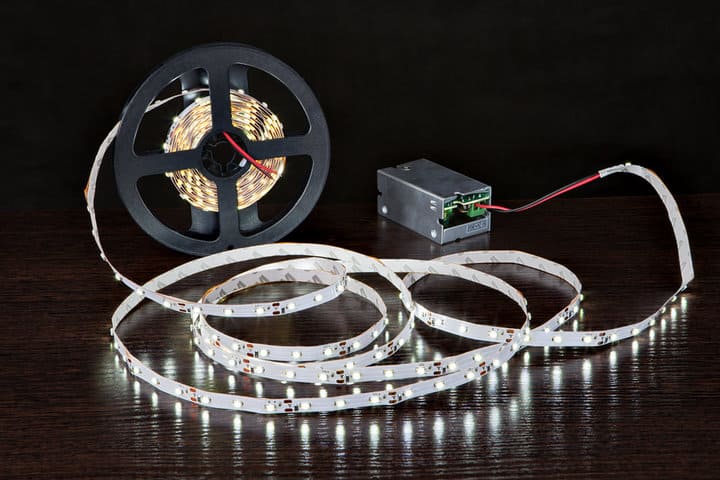
24-volt LED strips won’t work on a 12-volt supply. There’s not enough voltage energy to power the lights. you may get a faint light, but they certainly won’t work properly.
It’s really important to get the right power supply voltage for your LED strip light. A 12-volt supply just won’t be enough to get your 24-volt strip working.
If your existing electrical system, with 12-volt strips, doesn’t quite reach and you were hoping to add on a 24-volt strip you’ve found, it’s not worth trying.
At the same time, never connect a 12v LED strip to a 24-volt power supply. That’s way too much electrical energy.
12V strips can get excessively hot within a few seconds of being connected to a 24V power supply unit. The LEDs will get smoking hot and cause a fire.
At the very least, your LED strip will be damaged, and eventually, they will all burn out and stop working.
Final Word
For most home uses, a 12-volt LED strip light will be sufficient. But if you’re creating a bigger installation in your home, or it’s a commercial use, then it might be worth investing in more premium 24-volt LED strips.
They’re more efficient, and they run less risk of voltage drop.
What is your game plan for setting up your strip lights?
It’s always worth starting by working out how long your LED strip light installation needs to be.


